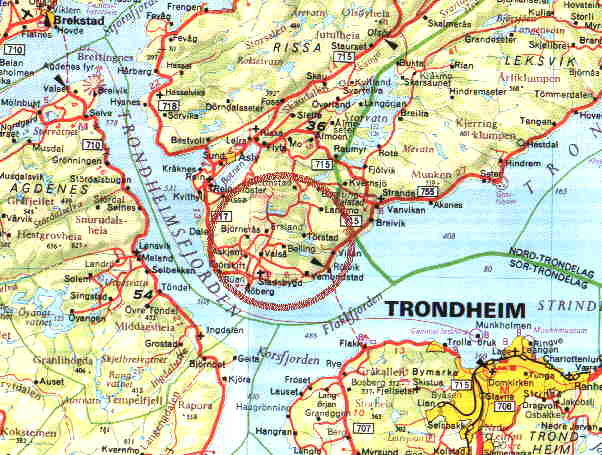Stadsbygd and Its People • Stadsbygd og staværinger
This
site: Bumerker • Emigration Dictionary • Farm and Personal Names • Genealogy • Given Names • Haarsager/Fenstad Names • Johan Bojer • Kinship • Links • Personal • Recipes • Stadsbygd Stories • Staværingsbåter (Boats) • Sør-Trøndelag Rural Districts • Thomas Angell • Travel to
Stadsbygd • Trøndelag Bygdebøker
Other
sites: Agdenes kommune • Coastal Heritage Museum • Farm
Names (Rygh) • FosenPortalen • Fosna-Folket newspaper • Indre Fosen kommune • Stadsbygd-Portalen
Stadsbygd
(pronounced "STAHS-bygd in the local dialect) is
a rural community in Sør-Trøndelag (South Trøndelag),
central
Norway, comprising about 1,500 people. It is located at the southern end of the Fosen
peninsula on the northern side of Trondheimsfjorden.
Staværinger
is the Norwegian word for "people from Stadsbygd."
Today, it is used to refer to people from Stadsbygd
proper, just as, for example, people from neighboring Rissa and Åfjord are called rissværing
and åfjording.
In this site, I am using the word to refer to people with some ancestral
tie to Stadsbygd.
As of January 1, 2018, Stadsbygd is part of
the municipality (kommune)
of Indre Fosen, which also includes Rissa and its Hasselvika
and Stjørna (formerly Skjørn)
communities, and Leksvik.

Stadsbygd to southeast from Bliksåskammen, June 2003
(Photo courtesy of Børge Solem)
The
old Stadsbygd parish (prestegjeld)
included what today is known as Stadsbygd, Rissa and Hasselvika on the north side of the fjord (now, along with Leksvik, in Indre Fosen kommune)
and Lensvik and Ingdalen on
the south side (now in Agdenes kommune). In the
past, it had a broader application. The rissværing,
Johan Bojer, used staværinger in
his classic 1921 novel, Den siste viking (published in
English as The Last of the Vikings)
for the fishing people of Sør-Trøndelag generally,
including his beloved Rissa. In an
unpublished 1958 letter, he said he was following Lofoten
speech (Lofoten is the prime cod fishing ground off
northwestern

Geographically,
Stadsbygd is located at 63.5° North latitude (similar
to Denali/Mt. McKinley in
Stadsbygd gets its name from Staðr or Stað (Old Norse
spelling), the old (pre-1500) name for the southernmost point of Fosen which
extends out into Trondheimsfjord and around which
ships must pass on their way from Trondheim as they turn there northwesterly to
the sea. Stad
means "place." Stad is also the name for
other promontories in Sogn og Fjordane county,
Most
of what I know about Stadsbygd and staværinger comes from several visits since 1986 ;
from the novels of Johan Bojer, who wrote from his
knowledge of the lives of people in the district; and most especially from
books written by my late 3rd cousin (firmenning),
Kristoffer Rein, Stadsbygd: Ei bok om bygda
og folket fra fjern fortid
og fram til
1980-åra (a four-volume history or bygdebøker
of the farms of Stadsbygd since the Reformation,
published between 1981 and 1988) and, with Kjell
Dahle, Stadsbygd Sparebank:
Bank og bygd i 100 år (a history of the
township and its bank, published in 1992).

Stadsbygd kirke, March 2001 (Photo by
Dennis Haarsager)
As
is the case in most rural communities around the world that have been settled
for centuries, staværinger are interrelated.
If you can trace an ancestor to Stadsbygd, the
chances are excellent that we are at least distantly related. Thanks to Kristoffer's bygdebøker
and help from several other staværinger in the
-- Dennis
L. Haarsager, Kittery Point, Maine, USA
Updated 4 Feb. 2018
